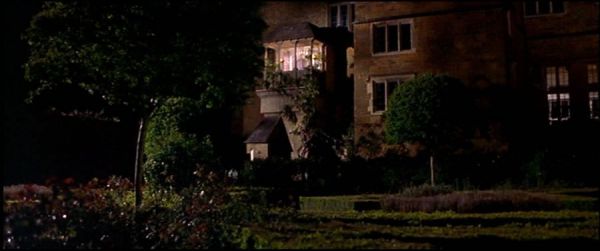Difference between revisions of "TCF340/BordwellThompson/Mise-en-scene (Discussion)"
(→Mise-en-scene: fixed case) |
ScreenAdmin (talk | contribs) m (5 revisions imported) |
||
| (3 intermediate revisions by one other user not shown) | |||
| Line 1: | Line 1: | ||
| − | + | Much as Bordwell/Thompson do with ''Our Hospitality'', we will examine the '''narrative functions''' of mise-en-scene in a short scene from ''[http://www.imdb.com/title/tt0138097/ Shakespeare in Love]'' (John Madden, 1998). (See [http://www.tcf.ua.edu/EO/DV/FilmArt/ShakespeareFromDVD.php video clip].) | |
| − | + | ==Plot summary== | |
| − | |||
| − | |||
| − | |||
| − | |||
| − | |||
| − | |||
| − | |||
| − | |||
[[Image:ShakespeareInLove006.jpg|thumb|left|600px|Opening shot from the ''Shakespeare in Love'' scene.]] | [[Image:ShakespeareInLove006.jpg|thumb|left|600px|Opening shot from the ''Shakespeare in Love'' scene.]] | ||
<br clear="all"> | <br clear="all"> | ||
| + | From http://www.imdb.com/title/tt0138097/plotsummary : | ||
| + | |||
| + | Romantic comedy set in London in the late 16th century: Young playwright William Shakespeare struggles with his latest work "Romeo and Ethel the Pirate's Daughter". A great fan of Shakespeare's plays is young, wealthy Viola who is about to be married to the cold-hearted Lord Wessex, but constantly dreams of becoming an actress. Women were not allowed to act on stage at that time (female roles were played by men, too), but dressed up as a boy, Viola successfully auditions for the part of Romeo. Soon she and William are caught in a forbidden romance that provides rich inspiration for his play. | ||
| + | |||
| + | ==Discussion questions== | ||
| + | #'''All groups:''' How do you pronounce "mise-en-scene"? | ||
| + | #'''Group 1:''' What narrative functions does the set design serve? | ||
| + | #'''Group 2:''' What narrative functions does the lighting design serve? | ||
| + | #*Does it use three-point lighting (explain what three-point lighting is)? | ||
| + | #*Is it high key or low key? | ||
| + | #'''Group 3:''' What narrative functions does the "behavior of figures" serve? | ||
| + | #*What do Bordwell/Thompson mean by that term? | ||
| + | #'''All Groups:''' What narrative functions does the costume design serve? | ||
== Bibliography == | == Bibliography == | ||
| Line 17: | Line 22: | ||
==External links== | ==External links== | ||
#[http://www.tcf.ua.edu/Classes/Jbutler/T440/VisualStyleIllustrations.htm Mise-en-scene Illustrations] | #[http://www.tcf.ua.edu/Classes/Jbutler/T440/VisualStyleIllustrations.htm Mise-en-scene Illustrations] | ||
| − | #[http://www.tcf.ua.edu/ | + | #[http://www.tcf.ua.edu/EO/DV/FilmArt/ShakespeareFromDVD.php ''Shakespeare in Love'' video clip] |
[[Category:TCF340 Discussion]] | [[Category:TCF340 Discussion]] | ||
Latest revision as of 21:31, 14 August 2019
Much as Bordwell/Thompson do with Our Hospitality, we will examine the narrative functions of mise-en-scene in a short scene from Shakespeare in Love (John Madden, 1998). (See video clip.)
Plot summary
From http://www.imdb.com/title/tt0138097/plotsummary :
Romantic comedy set in London in the late 16th century: Young playwright William Shakespeare struggles with his latest work "Romeo and Ethel the Pirate's Daughter". A great fan of Shakespeare's plays is young, wealthy Viola who is about to be married to the cold-hearted Lord Wessex, but constantly dreams of becoming an actress. Women were not allowed to act on stage at that time (female roles were played by men, too), but dressed up as a boy, Viola successfully auditions for the part of Romeo. Soon she and William are caught in a forbidden romance that provides rich inspiration for his play.
Discussion questions
- All groups: How do you pronounce "mise-en-scene"?
- Group 1: What narrative functions does the set design serve?
- Group 2: What narrative functions does the lighting design serve?
- Does it use three-point lighting (explain what three-point lighting is)?
- Is it high key or low key?
- Group 3: What narrative functions does the "behavior of figures" serve?
- What do Bordwell/Thompson mean by that term?
- All Groups: What narrative functions does the costume design serve?
Bibliography
- David Bordwell and Kristin Thompson, Film Art: An Introduction, 8th ed. (New York: McGraw-Hill, 2007).
